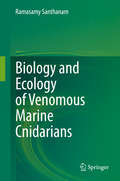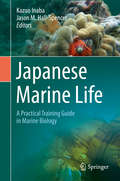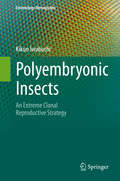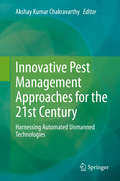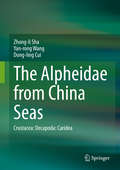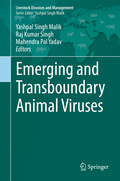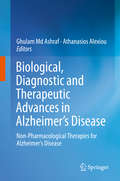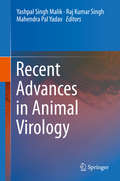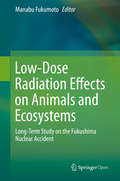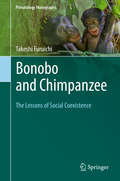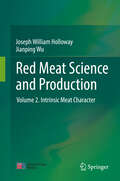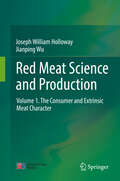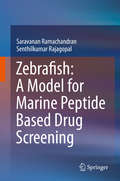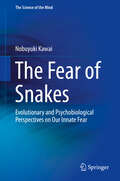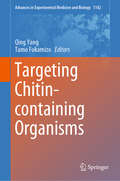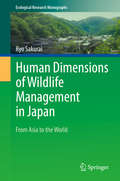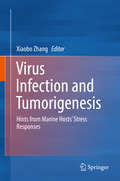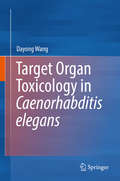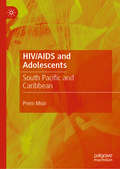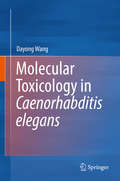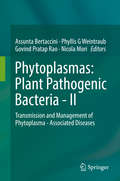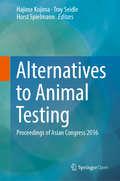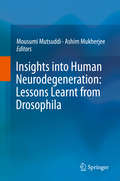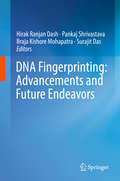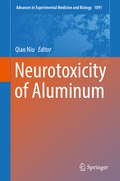- Table View
- List View
Biology and Ecology of Venomous Marine Cnidarians
by Ramasamy SanthanamSeas and oceans cover 71 % of the earth’s surface and they are home to 80% of all life found on the planet . Among the different components of marine life, the phylum Cnidaria (formerly Coelenterata) has been reported to be responsible for more envenomations than any other marine phylum. It is believed that 2% of its known 11000 species are venomous to humans. Incidents caused by jellyfish are common all around the globe, with serious manifestations and occasional deaths reported in some countries. The Australian box jellyfish, Chironex fleckeri , has been reported to be very dangerous to humans, as contact with its tentacles can provoke immediate cardiovascular collapse and death within minutes. Though other volumes on venomous marine fauna are available, this is the first comprehensive book focusing on venomous marine cnidarians. It is a valuable text-cum-reference resource for researchers, teachers and students of various disciplines, including fisheries science, marine biotechnology and marine biology and for university and college libraries. It is also a useful guide for beachgoers, divers, physicians and environmentalists.
Japanese Marine Life: A Practical Training Guide in Marine Biology
by Kazuo Inaba Jason M. Hall-SpencerThis book gives an overview of the diverse marine fauna and flora of Japan and includes practical guides for investigating the biology and ecology of marine organisms. Introducing marine training courses offered at a range of Japanese universities, this is the first English textbook intended for marine biology instructors and students in Japan. It provides essential information on experimental procedures for the major areas of marine biology, including cell and developmental biology, physiology, ecology and environmental sciences, and as such is a valuable resource for those in Asian countries that share a similar flora and fauna. It also appeals to visitors interested in attending Japanese marine courses from countries around the world.
Polyembryonic Insects: An Extreme Clonal Reproductive Strategy (Entomology Monographs)
by Kikuo IwabuchiThis book provides an overview of our current understanding of polyembryony in insects. The study of polyembronic insects has advanced considerably over the last several decades.The book shows the exciting potential of polyembryonic insects and their impact on life sciences. It describes the mechanisms of polyembryogenesis; tissue-compatible invasion of the host, which is the first case of compatible cellular interaction between phylogenetically distant organisms without rejection; the sex differences in defense; and the environmental regulation of caste structure. The first book devoted to polyembryony in insects, it draws on the author’s research on polyembryonic wasps from 1990 to the present day, covering various topics such as polyembryogenesis in vitro, host-parasite interaction, sex differences in soldier function/humoral toxic factor, and the transcription analysis of polyembryogenesis.It is intended not only for researchers in the field of entomology, parasitology, ontogeny, reproductive biology, developmental biology, sociobiology, and evolutionary developmental biology (Evo-Devo), but also for postgraduate students in these fields.
Innovative Pest Management Approaches for the 21st Century: Harnessing Automated Unmanned Technologies
by Akshay Kumar ChakravarthySeveral Integrated Pest Management (IPM) approaches are available for managing pests of varied kinds, including individual and integrated methods for pest suppression. Recently the focus has shifted to pest management tools that act on insect systems selectively, are compatible with the environment, and are not harmful for ecosystems. Other approaches target specific biochemical and physiological aspects of insect metabolism, and involve biotechnological and genetic manipulation. Still other approaches include the use of nanotechnology, endophytes, optical and sonic manipulation to detect and control pest insects. Unfortunately, conventional forms of pest management do not focus on technology transfer to the ground level workers and farmers. As a result, farmers are incurring huge losses of crops and revenues. This book highlights the importance of using communication tools in pest management and demonstrates some success stories of utilizing automated unmanned technologies in this context. The content is divided into three sections, the first of which, “Pest Population Monitoring: Modern Tools,” covers long and short-range pest population monitoring techniques and tools such as satellites, unmanned aerial vehicles/drones, remote sensing, digital tools like GIS, GPS for mapping, lidar, mobile apps, software systems, artificial diet designs and functional diversity of info-chemicals. The second section of the book is devoted to “Emerging Areas in Pest Management” and offers a glimpse of diversified tactics that have been developed to contain and suppress pest populations such as endophytes, insect vectors of phytoplasma, Hymenopterans parasitoids, mass production and utilization of NPV etc. In turn, the third section focuses on “Integrated Pest Management” and presents farming situations that illustrate how research in diversified aspects has helped to find solutions to specific pest problems, and how some new and evolving tactics can be practically implemented. Given its scope, the book offers a valuable asset for entomology and plant pathology researchers, students of zoology and plant protection, and readers whose work involves agriculture, horticulture, forestry and other ecosystems.
The Alpheidae from China Seas: Crustacea: Decapoda: Caridea
by Zhong-li Sha Yan-rong Wang Dong-ling CuiAs one of the largest families within the Caridea, the Alpheidae have attracted much attention for its species richness, especially on coral reefs. The Alpheidae are one of the most abundant decapods in tropical and subtropical areas, with 48 genera and more than 700 known species. The Alpheidae present a particular challenge in terms of both taxonomy and systematics as they are difficult to identify (some species vary in their growth and there are often large differences between the sexes). Traditional, morphology-based research on the Alpheidae still plays an important role in identifying species, compared with new methods, such as the short gene sequences. Based on more than 2000 specimens collected from the China Seas, this book describes and clearly illustrates 146 species belonging to 16 genera of the Alpheidae. It also presents the key features of every genus and every species within every genus, to enable readers to easily identify the alphid shrimps of the China Seas.
Emerging and Transboundary Animal Viruses (Livestock Diseases and Management)
by Yashpal Singh Malik Raj Kumar Singh Mahendra Pal YadavThis book, which is the first volume of the book series-Livestock Diseases and Management, summarizes the prominence and implications of the emerging and transboundary animal viruses. Although the livestock plays an important role in the economy of many countries, the emerging and transboundary animal viral diseases possess a serious risk to the animal-agriculture sector and food security globally. The book describes the precise and up-to-date information on animal viral diseases which have emerged in the recent past or are re-emerging due to various environmental factors and those which are not bounded in restricted national boundaries and attained the transboundary status. The chapters summarize the recent advancements in the molecular state-of-art tools towards the development of diagnostics, prophylactics, and therapeutics of these viruses. It also explicitly describes the challenges imposed by the emerging and transboundary viral infections and our preparedness to counter them.
Biological, Diagnostic and Therapeutic Advances in Alzheimer's Disease: Non-Pharmacological Therapies for Alzheimer's Disease
by Ghulam Md Ashraf Athanasios AlexiouThis book discusses the latest research into the highly prevalent neurodevelopmental disease most commonly associated with aging: Alzheimer’s disease (AD). Even after years of research, Alzheimer’s disease is still far from being cured. It presents a range of common symptoms in the form of behavioral and cognitive impairments. This book describes the symptoms and the biology behind them. The contents covers latest findings on the genetics involved and various factors and pathways influencing disease development. It also covers various non-pharmacological therapies like immunotherapy, use of natural products, and employing nanotechnology in both the detection and treatment of AD. This book also highlights the role of diet and nutrition in healthy aging. Given its scope, it offers a valuable asset for researchers and clinicians alike.
Recent Advances in Animal Virology
by Yashpal Singh Malik Raj Kumar Singh Mahendra Pal YadavThis book discusses the prominence and implication of the viral diseases that are a major threat to animals around the globe. A number of these diseases have also shown links with human populations, which has implications for public health. This book offers detailed and up-to-date information on viral diseases in livestock and poultry that were and/or are still a problem. Including cutting-edge developments, it also highlights several landmark contributions in the field of virology from India. Additionally, the book features tables and figures showing important clinical data and recommendations, with references for further information. It also explores the economic impact of viral diseases for farmers and the livestock industry, providing several examples. Further, it presents the latest information on viral diseases in global context, with a focus on state-of-art, molecular tools for the development of diagnostics, prophylactics and therapeutics. Lastly, the book also describes the challenges posed by the emerging and transboundary viral infections and our preparedness to counter them.
Low-Dose Radiation Effects on Animals and Ecosystems: Long-Term Study on the Fukushima Nuclear Accident
by Manabu FukumotoThis open access book summarizes the latest scientific findings regarding the biological effects of the Fukushima Daiichi Nuclear Power Plant (FNPP) accident in 2011.Various cases of changes in animals and organisms have been reported since the FNPP accident. However, it is often unknown whether they are actually due to radiation, since the dose or dose-rate are not necessarily associated with the changes observed. This book brings together the works of radiation biologists and ecologists to provide reliable radioecology data and gives insight into future radioprotection.The book examines the environmental pollution and radiation exposure, and contains valuable data from abandoned livestock in the ex-evacuation zone and from wild animals including invertebrates and vertebrates, aqueous and terrestrial animals, and plants that are subjected to long-term exposure in the area still affected by radiation. It also analyzes dose evaluation, and offers new perspectives gained from the accident, as well as an overview for future studies to promote radioprotection of humans and the ecosystem.Since the biological impact of radiation is influenced by various factors, it is difficult to scientifically define the effects of low-dose/low-dose-rate radiation. However, the detailed research data presented can be combined with the latest scientific and technological advances, such as artificial intelligence, to provide new insights in the future.This book is a unique and valuable resource for researchers, professionals and anyone interested in the impact of exposure to radiation or contamination with radioactive materials.
Bonobo and Chimpanzee: The Lessons of Social Coexistence (Primatology Monographs)
by Takeshi FuruichiThis book describes the similarities and differences between two species, bonobos and chimpanzees, based on the three decades the author has spent studying them in the wild, and shows how the contrasting nature of these two species is also reflected in human nature. The most important differences between bonobos and chimpanzees, our closest relatives, are the social mechanisms of coexistence in group life. Chimpanzees are known as a fairly despotic species in which the males exclusively dominate over the females, and maintain a rigid hierarchy. Chimpanzees have developed social intelligence to survive severe competition among males: by upholding the hierarchy of dominance, they can usually preserve peaceful relations among group members. In contrast, female bonobos have the same or even a higher social status than males. By evolving pseudo-estrus during their non-reproductive period, females have succeeded in moderating inter-male sexual competition, and in initiating mate selection. Although they are non-related in male-philopatric society, they usually aggregate in a group, enjoy priority access to food, determine which male is the alpha male, and generally maintain much more peaceful social relations compared to chimpanzees. Lastly, by identifying key mechanisms of social coexistence in these two species, the author also seeks to find solutions or “hope” for the peaceful coexistence of human beings."Takeshi Furuichi is one of very few scientists in the world familiar with both chimpanzees and bonobos. In lively prose, reflecting personal experience with apes in the rain forest, he compares our two closest relatives and explains the striking differences between the male- dominated and territorial chimpanzees and the female-centered gentle bonobos."Frans de Waal, author of Mama’s Last Hug - Animal Emotions and What They Tell Us about Ourselves (Norton, 2019)
Red Meat Science and Production: Volume 2. Intrinsic Meat Character
by Joseph William Holloway Jianping WuThis book comprehensively describes the biological underpinnings of red meat production, discussing the current state of the science in the context of the provision of red meat products perceived by consumers to offer a quality eating experience. Covering advances in the science of red meat production, it focuses on production system elements that affect product quality. The chapters explore the latest developments in the determination of consumer preferences, and interpret of these preferences in terms of quality characteristics of red meat, investigating the science-based orchestration of red meat production to achieve product consistency. The book highlights topics such as consumer preferences, the biological and production system elements affecting red meat safety, and the intrinsic (appearance, aroma, and sensory quality) and extrinsic (humane animal and environmentally friendly production) characteristics of red meat. For each characteristic, it discusses the underlying biological and biochemical processes and examines means of altering production systems to impact consumer eating experiences. The book also features a perspective on creating holistic integrated systems for producing red meats to meet consumers’ expectations around the globe. Written by leading authorities in the area of global red meat production systems, it is a comprehensive resource for consumer-oriented red meat producers.
Red Meat Science and Production: Volume 1. The Consumer and Extrinsic Meat Character
by Joseph William Holloway Jianping WuThis book comprehensively describes the biological underpinnings of red meat production, discussing the current state of the science in the context of the provision of red meat products perceived by consumers to offer a quality eating experience. Covering advances in the science of red meat production, it focuses on production system elements that affect product quality. The chapters explore the latest developments in the determination of consumer preferences, and interpret of these preferences in terms of quality characteristics of red meat, investigating the science-based orchestration of red meat production to achieve product consistency. The book highlights topics such as consumer preferences, the biological and production system elements affecting red meat safety, and the intrinsic (appearance, aroma, and sensory quality) and extrinsic (humane animal and environmentally friendly production) characteristics of red meat. For each characteristic, it discusses the underlying biological and biochemical processes and examines means of altering production systems to impact consumer eating experiences. The book also features a perspective on creating holistic integrated systems for producing red meats to meet consumers’ expectations around the globe. Written by leading authorities in the area of global red meat production systems, it is a comprehensive resource for consumer-oriented red meat producers.
Zebrafish: A Model for Marine Peptide Based Drug Screening
by Saravanan Ramachandran Senthilkumar RajagopalThis book offers a comprehensive overview of toxicology, highlighting the significance of peptide-based toxins from marine environments. It discusses the principles of protein-carbohydrate and domain-domain interactions to increase our understanding of toxicology in zebrafish models, as well as drug interaction mechanisms and target definition in drug discovery. It also reviews the structure of marine peptides/toxins and the toxicology of peptide secreting cells and cells that respond to these enzymes, and describes the normal and abnormal toxicology of marine peptides in zebrafish models. Offering insights into the field of proteomics, particularly current practice and research models for solving its many riddles, the book also explains the analytical principles of marine protein-protein and protein-carbohydrate interaction in the context of teratogenicity in target identification in peptide- based drug discovery. Lastly, the book methodically examines the preclinical research on marine proteins/peptides.
The Fear of Snakes: Evolutionary and Psychobiological Perspectives on Our Innate Fear (The Science of the Mind)
by Nobuyuki KawaiThis book provides a series of compelling evidence that shows that humans have innate fear of snakes. Building on the previous studies on the Snake Detection Theory (SDT), the author presents a summary of psychological and neuropsychological experiments to explain the fear of snakes in humans and primates. Readers will come to understand why and how we are afraid of snakes from an evolutionary perspective.The first half of the book discusses the history of psychological behaviorism and neobehaviorism. The latter half of the book consists mainly of the experimental studies performed by the author with a focus on three key items: First, compared with other animals, snakes especially draw the attention of primates and humans. Second, the ability of primates and humans to recognize snakes with particular efficiency. Third, processing mechanisms within the brain for snake detection is discussed from a new viewpointThe book offers a unique resource for all primatologists, psychologists, neuroscientists, anthropologists, herpetologists, and biologists who are interested in the evolution of visual and cognitive systems, mechanisms of fear, snakes or primates.
Targeting Chitin-containing Organisms (Advances in Experimental Medicine and Biology #1142)
by Qing Yang Tamo FukamizoThis book provides a comprehensive overview of chitin biology and chitin metabolism related enzymes. Chitin, the second most abundant biopolymer in nature after to cellulose, is a linear biopolymer composed of β-1,4-linked N-acetylglucosamine (GlcNAc), and an essential component in the exoskeletons of insects, mites, ticks and crustaceans, the egg shells of parasitic nematodes, and fungal cell walls. Although some chitin-containing organisms are a threat to human health, food safety and agricultural production, non-chitin containing organisms like humans, mammals and plants have an innate immune response to these hazardous organisms. The book provides researchers and students with information on the recent research advances concerning the biology of chitin-containing organisms as well as cross-talks between chitin-containing and non-chitin-containing organisms. Highlighting chitin remodeling enzymes and inhibitors, it also offers drug developers essential insights into designing specific molecules for the control of hazardous chitin-containing organisms.
Human Dimensions of Wildlife Management in Japan: From Asia to the World (Ecological Research Monographs)
by Ryo SakuraiThis book discusses the findings of research on the human dimensions of wildlife management conducted in Japan, demonstrating how such research and approaches have contributed to mitigating human-wildlife conflicts.Human-wildlife conflicts, including agricultural and property damage as well as occasional casualties, are a global problem for which local residents, managers, and stakeholders around the world are struggling to find solutions. Human dimensions of wildlife management (HDW) is an academic field developed in North America in the 1970s to gather information on the social aspects of human-wildlife issues to help wildlife managers and stakeholders implement effective decision-making measures. However, HDW is not widely recognized or applied outside North America, and few studies have investigated whether HDW approaches would be effective in different cultural settings.This is the first book written in English to introduce the HDW theories and practices implemented in Asia. Presenting innovative approaches and research techniques, as well as tips on how to introduce HDW methods into culturally different societies, it is a valuable resource not only for researchers and students in this field, but also for government officials/managers, NGOs, residents and other stakeholders who are affected by human-wildlife conflicts around the globe.
Virus Infection and Tumorigenesis: Hints from Marine Hosts’ Stress Responses
by Xiaobo ZhangThis book reviews the latest research on the molecules and mechanisms of marine host stress responses to viral infections and tumorigenesis. It offers an overview of the state of the art in the field as well as future directions. Metabolism disorder is a characteristic of tumorigenesis. Since viruses complete their life cycle in host cells, such infections cause metabolic disorders in the host. As such, the mechanisms of virus pathogenesis and tumor progression are similar or even identical. In essence, the role of antiviral molecules is to maintain the metabolic homeostasis of infected host cells, and the antiviral molecules induced by virus infection may play an important role in antitumor pathways, resulting in cancer cell death or restoring the disordered metabolism of cancer cells. The molecules generated during host stress responses to viruses can also contribute to the antitumor mechanisms in humans. However, the relationship between host stress responses to virus infection and tumorigenesis has not been extensively explored. In recent years, studies have shown that marine host stress responses to viral invasion can be good models for exploring human antitumor mechanisms. Stimulating further research in the field, this book offers graduate students and researchers with comprehensive insights into host stress responses to viral invasion and tumor progression. It is also a valuable resource for those working in the pharmaceutical industry interested in drug discovery based on molecules derived from host stress responses to viral infection.
Target Organ Toxicology in Caenorhabditis elegans
by Dayong WangThis book introduces readers to intestinal and epidermal barriers, and to toxicity induction of environmental toxicants or stresses in the intestine, epidermis, neurons, muscle, and reproductive organs in Caenorhabditis elegans. In addition, it discusses the protective responses of various organs and nematodes’ avoidance behaviour with regard to environmental toxicants or stresses. The intestinal, epidermal, neuronal, and germline signalling pathways required for the regulation of toxicity of environmental toxicants or stresses are also introduced and discussed. As a classic model animal with well-described genetic and developmental backgrounds, the nematode Caenorhabditis elegans has been successfully and widely used in both toxicity assessments and toxicological studies on various environmental toxicants and stresses. Once exposure to certain environmental toxicants has occurred, the toxicants can enter into the primary targeted organs (such as intestinal cells), and even be translocated into secondary targeted organs (such as reproductive organs and neurons). Based on related available data, this book provides a systematic understanding of target organ toxicology in C. elegans.
HIV/AIDS and Adolescents: South Pacific and Caribbean
by Prem MisirThis book addresses the relationship between high school students’ HIV and AIDS knowledge and their stigma-related attitudes/perceptions of people living with HIV (PLHIV) in the Caribbean and South Pacific, with a view to designing effective stigma-reduction combined intervention programs. Presenting an international cross-sectional study using a purposive sample of high school students from Fiji (South Pacific), Vanuatu (South Pacific), Guyana, and Antigua & Barbuda (Caribbean) to assess HIV and AIDS knowledge and stigma-related attitudes by gender, age, religion, race/ethnicity, and socioeconomic status, the book shows how stigmatizing attitudes and beliefs negatively impact interventions to prevent and treat HIV and AIDS.
Molecular Toxicology in Caenorhabditis elegans
by Dayong WangThis book will focus on the molecular basis of oxidative stress induced by toxicants or stresses and various molecular signalling pathways in regulating the toxicity of toxicants or stresses in Caenorhabditis elegans. It will also cover the discussion on the aspects of response signals, G-protein coupled receptors and ion channels, specific molecular signals, and epigenetic signals involved in the regulation of toxicity from toxicants or stresses. The molecular basis for adaptive response for transgenerational toxicity of environmental toxicants or stresses will be further discussed. Nematode Caenorhabditis elegans is a classic model animal with well-described genetic and developmental backgrounds based on the study of life science, and has been further successfully and widely used in both toxicity assessment and toxicological study of various environmental toxicants or stresses. Based on related available data, this book aims at providing a systematic understanding of the knowledge system of molecular toxicology in C. elegans.
Phytoplasmas: Transmission and Management of Phytoplasma - Associated Diseases
by Assunta Bertaccini Phyllis G Weintraub Govind Pratap Rao Nicola MoriPhytoplasma-associated diseases are a major limiting factor in the context of the quality and productivity of many ornamental, horticultural and other economically important agricultural crops worldwide. Annual losses due to phytoplasma diseases vary, but under pathogen-favorable conditions they have disastrous consequences for the farming community. As there is no effective cure for these diseases, the management options focus on their exclusion, minimizing their spread by insect vectors and propagation materials and on the development of host plant resistance.This book discusses the latest information on the epidemiology and management of phytoplasma-associated diseases, providing a comprehensive, up-to-date overview of distribution, occurrence and identification of the phytoplasmas, recent diagnostics approaches, transmission, losses and geographical distribution as well as management aspects.
Alternatives to Animal Testing: Proceedings of Asian Congress 2016
by Hajime Kojima Troy Seidle Horst SpielmannThis open access book presents recent advances in the pure sciences that are of significance in the quest for alternatives to the use of animals in research and describes a variety of practical applications of the three key guiding principles for the more ethical use of animals in experiments – replacement, reduction, and refinement, collectively known as the 3Rs. Important examples from across the world of implementation of the 3Rs in the testing of cosmetics, chemicals, pesticides, and biologics, including vaccines, are described, with additional information on relevant regulations. The coverage also encompasses emerging approaches to alternative tests and the 3Rs. The book is based on the most informative contributions delivered at the Asian Congress 2016 on Alternatives and Animal Use in the Life Sciences. It will be of value for those working in R&D, for graduate students, and for educators in various fields, including the pharmaceutical and cosmetic sciences, pharmacology, toxicology, and animal welfare. The free, open access distribution of Alternatives to Animal Testing is enabled by the Creative Commons Attribution license in International version 4: CC BY 4.0.
Insights into Human Neurodegeneration: Lessons Learnt from Drosophila
by Mousumi Mutsuddi Ashim MukherjeeThis book is aimed at generating an updated reservoir of scientific endeavors undertaken to unravel the complicated yet intriguing topic of neurodegeneration. Scientists from Europe, USA and India who are experts in the field of neurodegenerative diseases have contributed to this book. This book will help readers gain insight into the recent knowledge obtained from Drosophila model, in understanding the molecular mechanisms underlying neurodegenerative disorders and also unravel novel scopes for therapeutic interventions. Different methodologies available to create humanized fly models that faithfully reflects the pathogenicities associated with particular disorders have been described here. It also includes information on the exciting area of neural stem cells. A brief discussion on neurofibrillary tangles, precedes the elaborate description of lessons learnt from Drosophila about Alzheimer's, Parkinson’s, Spinomuscular Atrophy, Huntington’s diseases, RNA expansion disorders and Hereditary Spastic Paraplegia. We have concluded the book with the use of Drosophila for identifying pharmacological therapies for neurodegenerative disorders. The wide range of topics covered here will not only be relevant for beginners who are new to the concept of the extensive utility of Drosophila as a model to study human disorders; but will also be an important contribution to the scientific community, with an insight into the paradigm shift in our understanding of neurodegenerative disorders. Completed with informative tables and communicative illustrations this book will keep the readers glued and intrigued. We have comprehensively anthologized the lessons learnt on neurodegeneration from Drosophila and have thus provided an insight into the multidimensional aspects of pathogenicities of majority of the neurodegenerative disorders.
DNA Fingerprinting: Advancements and Future Endeavors
by Hirak Ranjan Dash Pankaj Shrivastava Braja Kishore Mohapatra Surajit DasThis book describes the basics and various applications of DNA fingerprinting, including in actual case studies. The book is divided in four modules; Module 1: Basics of DNA Fingerprinting, Module 2: Applications of DNA Fingerprinting, Module 3: DNA Fingerprinting: Case Studies, and Module 4: Future of DNA Fingerprinting. Each module consists of 4 to 5 chapters, written by reputed researchers, academics and forensic scientists from around the globe. The respective chapters cover e.g. related fields, the tools and techniques used, various genotyping kits, real-world case studies, ancient DNA and wild life forensics, molecular diagnosis of human diseases, legal aspects, microbial forensics and the economics of the DNA fingerprinting technique. The book offers a practical guide for professionals, graduate and post-graduate students in the fields of Forensic Science, Medicine, Genetics, Anthropology, Microbiology, and Zoology. It also serves as a useful reference resource, summarizing major technological advances in the field of DNA fingerprinting, the problems faced in this field of science and possible new solutions to these problems. Presently, DNA fingerprinting is utilized in solving the majority of criminal cases; as such, the book is also helpful for investigating agencies, as it includes representative case studies.
Neurotoxicity of Aluminum (Advances in Experimental Medicine and Biology #1091)
by Qiao NiuThis book reviews the scientific literature and the authors’ own research linking aluminum neurotoxicity with cognitive impairment and Alzheimer’s disease (AD). It focuses on aluminum levels in the brain, region-specific and subcellular distribution, and its relation to neurofibrillary tangles and amyloid beta. Further, the book stresses the importance of aluminum’s complex speciation chemistry in relation to biology, and details aluminum’s mechanism in oxidative stress and cell death, especially in connection with apoptosis and necroptosis. The electrophysiological variation and synaptic plasticity induced by aluminum are covered, while the metal’s debatable role in AD and the cross-talk between aluminum and genetic susceptibility are also discussed. In closing, the book reviews the neurotoxic effects of aluminum and its important role in the pathogenesis of AD. Given its depth of coverage, the book provides readers with a systematic summary of aluminum neurotoxicity.
